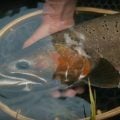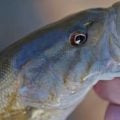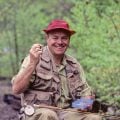Casco Bay, Maine: “Fifty More Places To Fly Fish Before You Die”

Linesider from the flats. Photo Liz Steketee
YOU’RE STANDING IN THE BOW of an Action Craft skiff as your guide poles you along flats that seem to stretch for miles. A warm sun lights the way. Suddenly several V-wakes appear at one o’clock, and the guide calls out, “Drop it on ‘em, 40 feet!” As you backcast, a lobster boat chugs into view, and distinctive Downeast accents can be heard over the diesel engine.
You know you’re not in Andros, but floating on Casco Bay, Maine casting to skinny water stripers!
For most of the thousands of fly anglers who chase stripers up and down the eastern seaboard, flats and floating lines are not a significant part of the equation. It’s all about structure, bulky flies and sink tips. It was not much different for Eric Wallace… until the revelation came. “I was out with a client, poling along a section of shoreline in four or five feet of water. The angler set his rod on the gunnel, and as we ripped off over some flats to get to another spot, the rod fell off. I made careful note of where it went in—I knew there were clammers who worked the flat, and I wanted to find the rod before they did. On my next day off, I headed out to the flat. It was kind of mucky, but there was a mussel bar to the left where I could walk in. As I poked around for the rod, I noticed V-wakes off to the side—in bright sun, in 1.5 feet of water! The fish were coming on to this flat much earlier than I’d ever imagined. Figuring out how to catch them has consumed my angling for the last seven years.”
Casco Bay stretches east and north some 220 square miles from Portland. While not quite “Downeast” Maine in terms of location, Casco Bay has the rocky coastline and pine-dotted coves that define the state for many visitors. Much of the shoreline structure in Casco Bay occurs around the Calendar Islands, a series of more than 200 rocky outcroppings around the bay. (An early explorer dubbed them the Calendars, as there were so many, he believed there to be one for each day of the year.) Though in the shadow of the Pine Tree State’s largest city, Casco Bay has maintained much of its wild flavor; you’re as likely to be accompanied by seals and porpoises as you move from flat to flat as you are other anglers. Several factors contribute to Casco Bay’s fecundity as a striped bass fishery, despite being near the northern boundary of the species’ range. The Bay is fed by a number of rivers, including the Presumpscot, the Androscoggin, and the Kennebec—which attract a host of forage fish, including herring, alewives, smelt, and eel. Beyond the river mouths, Casco Bay offers nearly 15,000 acres of mud and sand flats, with powerful seven to thirteen foot tides cycling fresh water (and fresh bait) through the region throughout the day. “It’s like a soup kitchen out there,” Eric continued. “There are countless channels that run through the flats, and you can follow the tide changes for a long time. The stripers are social creatures, and one small group will take up with another until you have quite a group of fish assembled.”
Fly fishing the flats of Casco Bay will be an adjustment for most striper fishermen accustomed to blind-casting into rips or structure or dropping big Clousers into schools of fish busting bait. In fact, there may be more parallels to fishing Caribbean flats for bonefish or permit. (It’s no surprise that Eric Wallace helped pioneer this tactic—he’s a longtime Florida flats guide!) For starters, anglers can leave the fast-sinking lines and foot-long baitfish patterns in the car—this is mostly a floating line game. Second, some anglers may need to adjust their expectations. “Some striper fishermen are numbers guys,” Eric continued. “This kind of fishing is more challenging than other methods. You’ve got to cast very accurately to the fish and feed them. Many times, you have to crack them right on the head, using a long leader and fairly light tippet—10 or 12 pound fluorocarbon. Sometimes the fish will spook, but other times they’ll come right to it. I’ll often use crab patterns instead of baitfish imitations, which also takes some adjustment. Anglers have to react quickly, as the window to make the presentation is brief. The ‘Aha!’ moment for people not accustomed to this type of fishing comes when the 17-foot boat is resting on some mud flats and they see stripers waking in next to no water. When they step onto the casting platform and make a throw, they suddenly understand the value of the flats, which they’ve generally ignored in terms of water. There are no birds diving, no baitfish churning, but from up on the poling platform I might see 100 fish. The thought bubble over their head says ‘Wow, there are opportunities here!’”
One difference from Caribbean flats fishing that Eric pointed out—hooked stripers might sometimes run off the flat and wrap themselves around a lobster buoy… and some mornings, you might be wearing a heavy fleece and a watch cap.
Chasing stripers on the flats is a special experience that’s likely to burnish memories that will be shared with striper devotees and infrequent saltwater anglers alike. On a recent June day, Eric had the chance to share the experience with two very special future angle—his twin five year-old girls. “I had done a morning guiding trip that had gone well, and by lunchtime, the weatherman was predicting that the temperature would hit 90—not terribly common for Maine. My wife suggested that we all head out to a nice beach we know of out on one of the islands in Casco Bay for a picnic. We motored out there, and after the family was settled, I poled over to a sand flat just a little ways from the beach. Pretty soon I was sight-fishing to 30-inch stripers. I made seven casts with green crab patterns, and hooked five fish, with a bright mid-day sun… in Maine! Better yet, my kids saw what was going on, and got to watch. They see my boat parked in the driveway and know that I take people fishing, but I don’t think they really understood what my job was about until this moment. Watching one of my girls running up the beach with a big smile as I landed one of those fish is my most treasured fishing memory.”
Capt. Eric Wallace is a fanatic saltwater fisherman and fly tier with 20 years of guiding behind him, devoting his life to catching fish in and around the ocean and sharing that experience with others. His knowledge of the ocean ecosystem, his patience, enthusiasm, and teaching ability have won him accolades and features in magazines such as Fly Fishing in Saltwaters, Gray’s Sporting Journal, Saltwater Fly Fishing, On The Water, Outdoor Life, among many others. In 2010 he co-hosted a TV show for a sportfishing magazine. He is a creative fly-tier who has developed dozens of patterns for both Northeast saltwater and tropical flats fishing. His flies and techniques are featured in Dave Klausmeyer’s Patterns of the Pros.
Eric’s experiences guiding in other areas of the country—including the Florida Keys, the Frying Pan River in Colorado, the Deschutes in Oregon, and fabled trout waters of Michigan—guarantee clients a memorable trip, regardless of experience level, conditions or weather. He is on the pro staff of Scott Fly Rods and Hatch Fly Reels. He and his wife Melissa and twin daughters, Heidi and Emily, live in Maine and spend winters in the lower Florida Keys.
Getting There: Casco Bay adjoins Portland, Maine, which is served by many carriers, including Delta and United Airlines.
Prime Time: Stripers usually begin arriving in Casco Bay in early June and fishing remains strong through September.
Accommodations: Eric recommends two properties in Freeport—Harraseeket Inn (800-342-6423) and Applewood Inn B&B (877-954-1358). Another fine option is the Chebeague island Inn (207-846-5155), out in Casco Bay.
Guides/Outfitters: Eric Wallace (207-671-4330; www.coastalflyangler.com) helped pioneer “flats-style” striper fishing in Casco Bay.
Equipment: An 8- or 9-weight rod with floating line and an assortment of crab patterns will serve you well.
Copyright © 2011 Chris Santella. Excerpted from Fifty More Places To Fly Fish Before You Die with permission from Stewart, Tabori & Chang.











